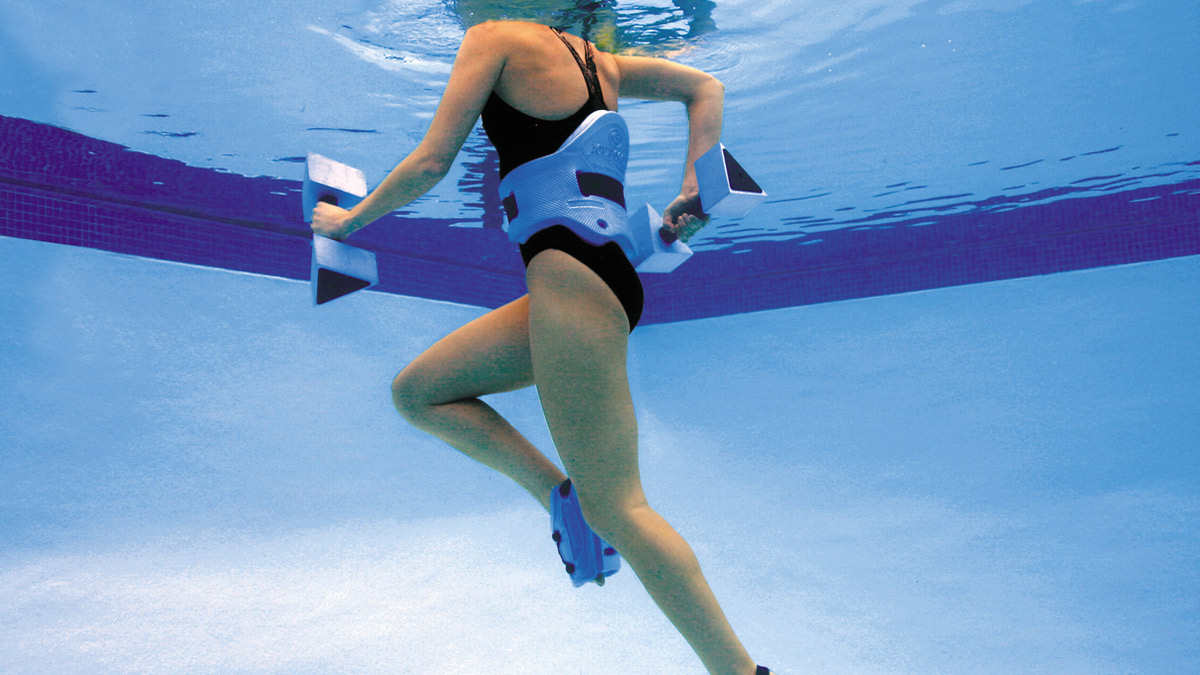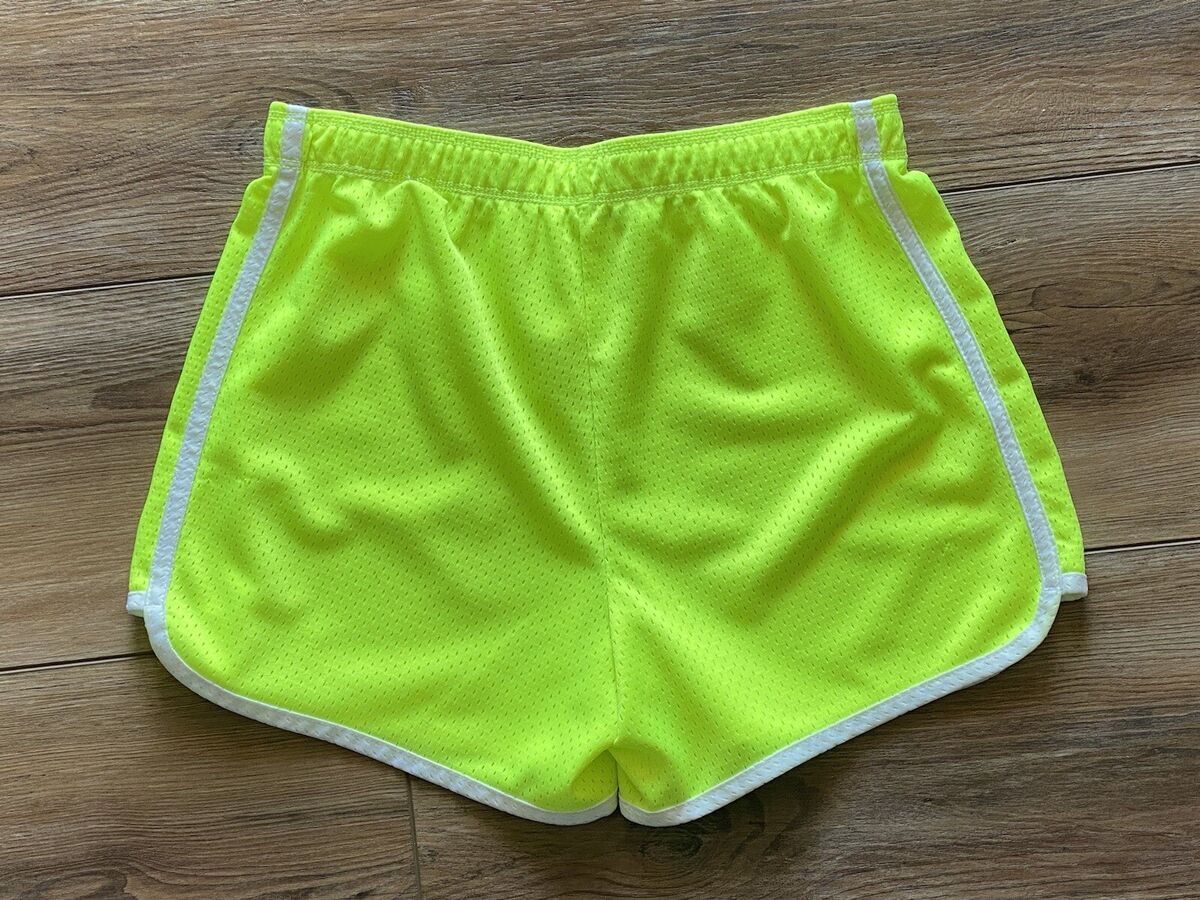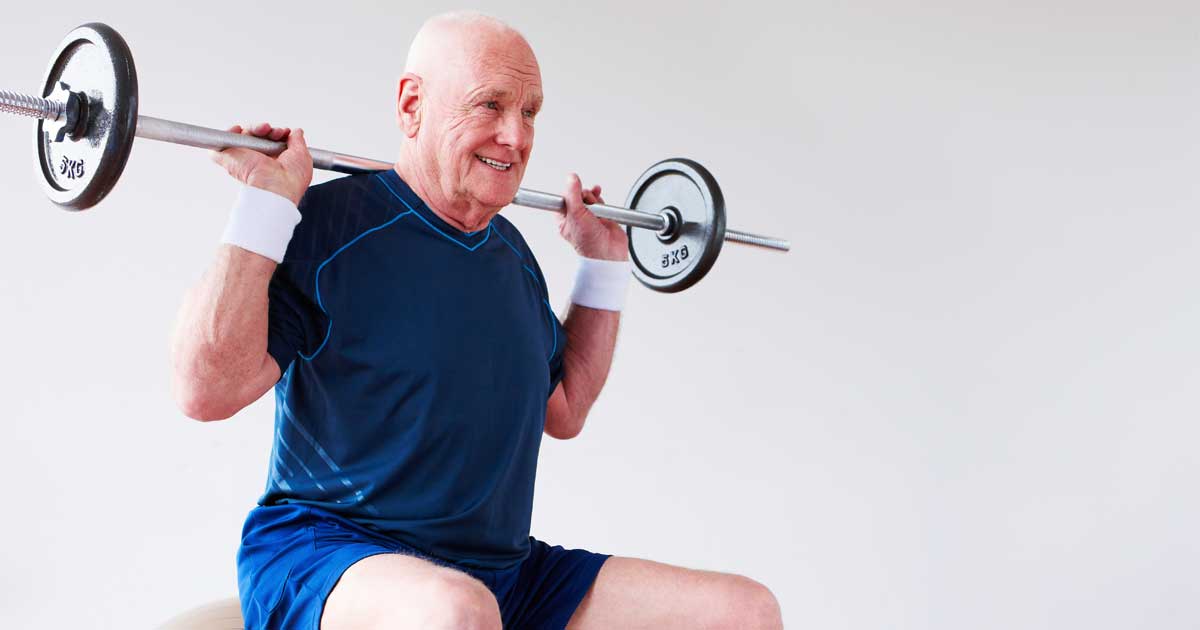

Featured
What Is Aqua Jogging
Modified: August 21, 2023
Discover the benefits and techniques of aqua jogging with our informative guide. Stay in shape and make a splash with our featured aqua jogging workouts.
Introduction
Welcome to the world of Aqua Jogging, a unique and effective form of exercise that combines the benefits of running with the low-impact nature of water. Whether you are an avid runner looking to mix up your training routine or someone recovering from an injury, Aqua Jogging can offer you a refreshing and revitalizing workout experience.
So, what exactly is Aqua Jogging? In simple terms, it is the act of running in place while submerged in water. This form of exercise provides the same cardiovascular benefits as traditional running, but with far less stress on your joints and muscles. It’s a fantastic option for individuals with joint pain, recovering from surgeries, or simply looking to add variety to their workout regimen.
To engage in Aqua Jogging, all you need is a pool or body of water deep enough to allow you to maintain buoyancy. You don’t need to be an expert swimmer; the water will do most of the work for you! Aqua Jogging can be performed with or without specialized equipment, making it accessible and adaptable to all fitness levels.
In this comprehensive guide, we will walk you through everything you need to know about Aqua Jogging, including its benefits, how to get started, and safety precautions to keep in mind. We’ll also explore the differences between Aqua Jogging and traditional running, highlighting the unique advantages that this aquatic exercise has to offer. Whether you’re a seasoned athlete or new to fitness, Aqua Jogging is a fantastic way to challenge your body and enjoy the numerous benefits of exercising in water.
Definition of Aqua Jogging
Aqua Jogging, also known as water running or deep-water running, is a form of aerobic exercise where individuals perform a running motion while submerged in water. It is a low-impact form of exercise that mimics the movements and cardiovascular benefits of running on land, but with reduced stress on joints, muscles, and bones.
The concept behind Aqua Jogging is simple. By wearing a buoyancy belt or using other flotation devices, participants can maintain an upright position in deep water while engaging in a running motion. The water provides resistance, making it a challenging workout that targets various muscles throughout the body.
Unlike traditional running, Aqua Jogging does not require solid ground contact. This eliminates the repetitive impact on joints commonly associated with running on pavement or treadmills. The buoyancy of water reduces the effects of gravity on the body, creating a weightless environment that helps reduce stress and pressure on sensitive areas, such as the knees and hips.
Aqua Jogging is suitable for people of all fitness levels, from beginners to athletes in training. The intensity of the workout can be adjusted by altering the speed and resistance in the water. It’s a versatile form of exercise that can be customized to meet individual needs and goals.
Many individuals turn to Aqua Jogging as a way to stay active and maintain cardiovascular fitness while recovering from injuries. It can be particularly beneficial for those rehabilitating from joint surgeries, stress fractures, or muscle strains. The gentle nature of water eliminates the risk of further injury and allows individuals to regain strength and mobility without placing excessive pressure on healing tissues.
Overall, Aqua Jogging provides a fun and effective alternative to traditional running. It offers the same health benefits, including improved cardiovascular endurance, calorie burning, and muscle toning, while minimizing the risk of injury and providing a refreshing experience in the water.
Equipment Needed for Aqua Jogging
Aqua Jogging is a simple and accessible exercise that requires minimal equipment. Here are the key items you’ll need to get started:
- Buoyancy Belt: The most important piece of equipment for Aqua Jogging is a buoyancy belt or aqua belt. This belt is worn around your waist and provides buoyancy, allowing you to maintain an upright position in the water. It helps to keep your head and shoulders above the water, mimicking the natural body position during running.
- Swimsuit: Opt for a comfortable swimsuit that allows for a wide range of movement. Choose a style that you feel confident and secure in, as you’ll be moving vigorously in the water.
- Waterproof Fitness Tracker: While not necessary, a waterproof fitness tracker or smartwatch can be a valuable tool to monitor your heart rate, track your workout duration, and keep a record of your progress. It can add an extra layer of motivation and help you stay on track with your fitness goals.
- Waterproof Earphones: If you enjoy listening to music, consider investing in waterproof earphones. Listening to your favorite tunes or podcasts can make your Aqua Jogging sessions more enjoyable and help you stay focused and motivated.
- Water Shoes: While not essential, water shoes can provide added traction and protection, especially if the pool floor is slippery or you’re jogging in an outdoor body of water. They can help prevent slips and falls when performing high-intensity movements in the water.
These are the basic equipment items that will enhance your Aqua Jogging experience. Depending on your personal preferences and needs, you may choose to add other equipment such as flotation dumbbells or hand paddles to increase resistance and challenge your muscles even more. However, remember that Aqua Jogging can be done with just a buoyancy belt and swimsuit, making it a cost-effective and accessible workout option.
Now that you know what equipment you’ll need, let’s dive deeper into the benefits of Aqua Jogging and why it’s worth incorporating into your fitness routine.
Benefits of Aqua Jogging
Aqua Jogging offers a wide range of benefits for individuals of all fitness levels. Let’s explore some of the key advantages of incorporating Aqua Jogging into your workout routine:
- Low-Impact Exercise: One of the primary benefits of Aqua Jogging is its low-impact nature. The buoyancy of water reduces the stress on your joints, making it an ideal exercise for those with joint pain, arthritis, or recovering from injuries. It allows you to enjoy the cardiovascular benefits of running without the risk of high-impact injuries.
- Full-Body Workout: Aqua Jogging engages multiple muscle groups throughout your body. The resistance of the water forces your muscles to work harder, leading to improved muscular strength and endurance. It targets your core, arms, legs, and back, providing a complete body workout.
- Cardiovascular Endurance: By maintaining a consistent running motion in the water, Aqua Jogging increases your heart rate and improves cardiovascular endurance. It helps to strengthen your heart and lungs, leading to enhanced stamina and overall fitness.
- Improved Joint Mobility: Aqua Jogging allows for a wider range of motion in your joints compared to activities on land. The water supports your body weight and reduces the impact on your joints, promoting better joint mobility and flexibility.
- Weight Management: Aqua Jogging is an effective calorie-burning exercise. It helps you shed excess pounds and maintain a healthy weight. The resistance provided by the water increases the intensity of the workout, helping you burn more calories compared to traditional running.
- Enhanced Recovery: Aqua Jogging is widely utilized for injury rehabilitation. The low-impact nature of the exercise allows individuals to rebuild strength and range of motion without putting excessive stress on healing tissues. It can be particularly beneficial for athletes recovering from joint surgeries, stress fractures, or muscle strains.
- Reduced Muscle Soreness: The water’s buoyancy acts as a natural form of resistance, reducing the impact on your muscles and lowering the likelihood of post-workout soreness. Aqua Jogging can assist in alleviating muscle tension and promoting faster recovery.
- Mental Relaxation: Exercising in water has a relaxing and therapeutic effect on the mind. The soothing properties of water help reduce stress levels, improve mood, and promote a sense of calmness and well-being.
As you can see, Aqua Jogging offers numerous benefits for individuals seeking a challenging and low-impact workout. Whether you’re recovering from an injury, looking to improve cardiovascular endurance, or simply wanting to mix up your exercise routine, Aqua Jogging is a fantastic option to consider.
How to Aqua Jog
Aqua Jogging may seem different from traditional running, but with a few simple steps, you’ll be able to master the technique and enjoy the benefits of this unique form of exercise. Here’s a step-by-step guide on how to Aqua Jog:
- Get the right equipment: Before you start Aqua Jogging, make sure you have the necessary equipment, including a buoyancy belt or aqua belt and a swimsuit. Optional equipment such as water shoes, waterproof earphones, and a waterproof fitness tracker can enhance your experience.
- Find a suitable location: Look for a pool or body of water that is deep enough to allow you to maintain buoyancy while standing. Make sure the water is safe and clean for swimming.
- Put on the buoyancy belt: Securely fasten the buoyancy belt around your waist. Adjust it to a comfortable tightness that allows you to maintain an upright position in the water.
- Enter the water: Step into the water, ensuring it is deep enough to submerge your body up to shoulder or chest level. Take a moment to adjust to the temperature and get used to the sensation of being in the water.
- Start jogging: Begin by marching or walking in place to warm up your muscles. Then, transition into a jogging motion, lifting your knees and driving your arms as you would while running on land.
- Maintain proper form: Keep your back straight, shoulders relaxed, and head above the water. Engage your core muscles to stabilize your body. Avoid leaning forward or backward, as this can affect your posture and overall balance.
- Vary your speed and intensity: Experiment with different speeds and intensities to challenge yourself and target different muscle groups. You can increase the pace for a more intense cardio workout or slow down for a gentle, recovery-focused session.
- Alternate arm movements: Incorporate alternating arm movements to engage your upper body. As you lift one knee, swing the opposite arm forward, mimicking the natural arm swing of running. This will help maintain balance and increase the overall intensity of the workout.
- Stay hydrated: Remember to drink water regularly, even though you’re surrounded by it. Dehydration can still occur during exercise, so take sips of water between intervals or as needed.
- Cool down and stretch: Just like with any exercise, it’s important to cool down and stretch your muscles afterward. Gradually decrease your pace and finish with gentle stretching to promote flexibility and prevent muscle tightness.
With consistent practice and proper technique, Aqua Jogging can become an enjoyable and effective part of your fitness routine. Whether you choose to go solo or join an Aqua Jogging class, embrace the unique experience of running in water and reap the benefits it has to offer.
Safety Precautions for Aqua Jogging
Aqua Jogging is generally a safe and low-impact exercise, but like any physical activity, it’s important to take certain precautions to ensure a safe and enjoyable experience. Here are some safety guidelines to keep in mind when Aqua Jogging:
- Consult with a healthcare professional: If you have any existing medical conditions or concerns, it’s always best to consult with a healthcare professional before starting any new exercise program, including Aqua Jogging.
- Use proper flotation devices: Choose a buoyancy belt or aqua belt that fits securely and provides enough buoyancy to keep you afloat in the water. Ensure that it is properly fastened and adjusted to your body for optimal support and stability.
- Pay attention to your surroundings: Be aware of your surroundings in the pool or body of water you’re using for Aqua Jogging. Be mindful of other swimmers and avoid collisions by choosing a designated area or lane for your workout.
- Gradually increase intensity: Start at a comfortable pace and gradually increase the intensity of your Aqua Jogging sessions over time. This will allow your body to adapt to the exercise and reduce the risk of overexertion or injury.
- Listen to your body: Pay attention to any discomfort or pain during your Aqua Jogging session. If you experience any unusual or sharp pains, stop exercising and seek medical attention if necessary. It’s important to listen to your body and not push through pain.
- Stay hydrated: Even though you’re surrounded by water, it’s still essential to stay hydrated. Drink water regularly during and after your Aqua Jogging sessions to prevent dehydration.
- Wear appropriate swimwear: Choose a comfortable and well-fitting swimsuit that allows for a full range of movement. Avoid loose or baggy clothing that may become a hindrance while exercising in the water.
- Practice good hygiene: Before entering the pool, shower to remove any oils, lotions, or contaminants from your body. This helps maintain the cleanliness of the pool water and promotes a healthy swimming environment.
- Be cautious with pool edges and ladders: When entering or exiting the pool, be cautious of slippery surfaces around the pool edges and ladders. Take your time and use handrails or other support to ensure stability and prevent falls.
- Follow pool rules and regulations: Familiarize yourself with the specific rules and regulations of the pool facility where you’re Aqua Jogging. Follow all signage and guidelines to ensure the safety of yourself and others.
By following these safety precautions, you can minimize the risk of injuries and enjoy a safe and rewarding Aqua Jogging experience. Remember to listen to your body, take it at your own pace, and have fun while reaping the benefits of this fantastic low-impact exercise.
Aqua Jogging vs. Traditional Running
Aqua Jogging and traditional running are both effective forms of exercise that offer unique benefits. Let’s compare the two to help you understand the key differences between Aqua Jogging and traditional running:
- Impact on Joints: Traditional running is a high-impact activity that can put stress on your joints, especially if you run on hard surfaces like concrete or pavement. Aqua Jogging, on the other hand, is a low-impact exercise that reduces the strain on your joints due to the buoyancy of water. This makes it a suitable option for individuals with joint pain, arthritis, or those recovering from injuries.
- Cardiovascular Benefits: Both Aqua Jogging and traditional running provide cardiovascular benefits, improving heart health, and increasing endurance. However, Aqua Jogging can be equally effective or even more intense due to the resistance offered by the water. The water’s resistance engages more muscles, resulting in an added cardiovascular challenge.
- Muscle Engagement: Traditional running primarily engages the muscles of your lower body, including the quadriceps, hamstrings, calves, and glutes. Aqua Jogging, on the other hand, engages a broader range of muscles. The water’s resistance requires your entire body to work, activating your core, arms, and upper body as you maintain balance and stability.
- Injury Risk: Traditional running carries a higher risk of injuries such as stress fractures, shin splints, and joint pain due to the impact on hard surfaces. Aqua Jogging significantly reduces the risk of these injuries as the water cushions the impact and supports your body weight. It can be an effective rehabilitation exercise for those recovering from injuries or looking for a low-impact workout option.
- Variety and Cross-Training: Aqua Jogging offers a refreshing change of scenery and a break from the repetitive motion of traditional running. It can be a great way to cross-train and give your body a break from the high-impact stress of running on land. Incorporating Aqua Jogging into your training routine can help prevent overuse injuries and add variety to your workouts.
- Environmental Factors: Traditional running is highly dependent on weather conditions and can be affected by extreme temperatures, rain, or snow. Aqua Jogging, on the other hand, can be performed indoors in a pool, offering a controlled and comfortable environment regardless of the weather outside.
- Recovery and Rehabilitation: Aqua Jogging is a popular choice for injury recovery and rehabilitation. The water’s buoyancy reduces stress on healing tissues, allowing individuals to maintain cardiovascular fitness and gain strength without the risk of aggravating their injuries. Traditional running, on the other hand, may need to be avoided during certain stages of recovery.
Both Aqua Jogging and traditional running have their merits and can be incorporated into your fitness routine based on your goals and preferences. If you’re looking for a low-impact exercise that is easy on the joints, offers full-body muscle engagement, and provides a refreshing change of scenery, Aqua Jogging is an excellent option to consider. If you enjoy the outdoors, value the simplicity of running, and prefer high-impact activities, traditional running might be your go-to choice. Remember to listen to your body, choose the exercise that aligns with your fitness level and goals, and always prioritize safety and enjoyment in your workouts.
Aqua Jogging for Injury Rehabilitation
Aqua Jogging is a highly beneficial exercise for individuals recovering from injuries and seeking a low-impact form of rehabilitation. Whether you’re rehabilitating from joint surgeries, stress fractures, or muscle strains, Aqua Jogging can play a significant role in your recovery journey. Here’s why Aqua Jogging is an effective tool for injury rehabilitation:
- Low-Impact Exercise: Aqua Jogging is a low-impact exercise that reduces the stress and impact on your joints, allowing you to maintain cardiovascular fitness without putting excessive strain on healing tissues. The buoyancy of water supports your body weight, minimizing the risk of aggravating existing injuries or causing new ones.
- Muscle Strengthening and Conditioning: Aqua Jogging engages a wide range of muscles throughout your entire body, including your core, arms, legs, and back. The resistance provided by the water forces your muscles to work harder, promoting muscle strength and endurance without the risk of straining or overloading injured muscles.
- Range of Motion and Flexibility: The water’s buoyancy allows for a wider range of motion in your joints compared to land-based exercises. Aqua Jogging can help improve joint mobility and flexibility, aiding in the rehabilitation process and preventing stiffness or loss of movement that can occur during recovery periods.
- Cardiovascular Endurance: By maintaining a consistent running motion in the water, Aqua Jogging helps improve cardiovascular endurance. It strengthens your heart and lungs, promoting better overall fitness and stamina. This is particularly beneficial for individuals who may be limited in their ability to engage in high-impact cardiovascular activities during their recovery.
- Improved Circulation: Aqua Jogging stimulates blood flow throughout your body, promoting enhanced circulation. Better blood flow aids in the delivery of oxygen and nutrients to injured tissues, facilitating the healing process and reducing inflammation and swelling.
- Psychological and Emotional Benefits: Recovery from injury can be mentally challenging, especially if it involves a break from regular physical activities. Aqua Jogging allows individuals to maintain an active lifestyle during their recovery, providing a sense of accomplishment, positive energy, and improved mental well-being.
- Gradual Progression: Aqua Jogging offers the flexibility to adjust the intensity and duration of your workouts based on your individual recovery progress. You can gradually increase the intensity as your condition improves, working closely with your healthcare professional or physical therapist to ensure safe and effective rehabilitation.
- Continuity of Training: For athletes or individuals who are accustomed to regular physical training, Aqua Jogging can serve as a way to maintain training continuity during the recovery period. It allows you to sustain cardiovascular conditioning and build strength without compromising your healing process.
Remember to consult with your healthcare professional or physical therapist before incorporating Aqua Jogging into your rehabilitation routine. They can provide specific guidance and tailor the exercise to your individual needs and injury requirements. Aqua Jogging can be a valuable tool in your recovery journey, providing a safe, low-impact, and effective form of exercise that promotes healing, strength, and overall well-being.
Aqua Jogging for Fitness Training
Aqua Jogging is not only beneficial for injury rehabilitation but also serves as an excellent form of fitness training. Whether you’re looking to improve your cardiovascular endurance, build strength, or add variety to your workout routine, Aqua Jogging can be a valuable addition to your fitness regimen. Here’s why Aqua Jogging is a fantastic option for fitness training:
- Low-Impact Cardiovascular Exercise: Aqua Jogging provides a challenging cardiovascular workout without the high-impact stress on your joints. The resistance of the water increases the intensity of the exercise, helping to elevate your heart rate and improve cardiovascular endurance. It’s an excellent option for individuals with joint pain, older adults, or those seeking a low-impact alternative to traditional running.
- Muscle Toning and Conditioning: Aqua Jogging engages multiple muscle groups throughout your body, including your core, arms, legs, and back. The resistance provided by the water helps to tone and strengthen your muscles, improving overall muscle definition and enhancing muscular endurance.
- Improved Core Strength and Balance: Aqua Jogging requires you to engage your core muscles to maintain proper form and stability in the water. The water’s resistance challenges your core and helps develop strength, stability, and balance. This can have a positive impact on your overall posture and athletic performance.
- Versatility and Customization: Aqua Jogging offers a high level of versatility and can be customized to meet individual fitness goals. You can adjust the intensity of your workout by varying your speed, incorporating intervals, or using additional equipment like flotation dumbbells or hand paddles. This allows you to continually challenge yourself and progress in your training.
- Recovery and Active Rest: Aqua Jogging can serve as a form of active recovery or active rest day from more intense workouts. It provides a low-impact option that allows you to maintain your fitness routine while giving your body a break from high-impact activities. The water’s buoyancy helps to reduce muscle soreness and promote faster recovery.
- Increase Caloric Burn: Aqua Jogging can be a highly effective calorie-burning exercise. The combination of cardiovascular and strength training elements, along with the resistance from the water, results in an increased calorie burn compared to traditional land-based exercises.
- Fun and Refreshing Workout: Aqua Jogging provides a unique and refreshing workout experience. The sensation of being in the water adds an element of enjoyment and can make workouts more fun and engaging. This can help you stay motivated and committed to your fitness routine.
- Avoiding Weather Constraints: Aqua Jogging can be performed indoors in a pool, offering a controlled environment free from weather constraints. This makes it a convenient year-round fitness option, regardless of the climate or weather conditions outside.
Whether you’re an avid runner looking to diversify your training routine or simply searching for an effective and low-impact workout, Aqua Jogging is an excellent choice for fitness training. It allows you to improve cardiovascular fitness, build strength, and engage your muscles in a refreshing and enjoyable way. So, dive into the water, embrace the resistance, and make Aqua Jogging a part of your fitness journey.
Conclusion
Aqua Jogging is a fantastic exercise option that offers numerous benefits for individuals of all fitness levels. Whether you’re recovering from an injury, looking for a low-impact workout, or seeking to enhance your cardiovascular endurance and muscle strength, Aqua Jogging can meet your needs. By running in water, you can enjoy all the advantages of traditional running while minimizing the impact on your joints and muscles.
Throughout this guide, we’ve discussed the definition of Aqua Jogging, the equipment needed, the benefits it offers, how to perform Aqua Jogging, safety precautions to consider, and its comparison to traditional running. We’ve also highlighted Aqua Jogging’s value in injury rehabilitation and fitness training.
From its low-impact nature and full-body engagement to its cardiovascular benefits and versatility, Aqua Jogging provides a refreshing and effective way to exercise. It allows you to maintain fitness, build strength, and improve your overall well-being without placing excessive stress on your body.
Whether you’re just starting out or an experienced athlete, Aqua Jogging can be adapted to meet your specific goals and preferences. Always remember to listen to your body, adapt the exercises to your fitness level, and consult with a healthcare professional or physical therapist if you have any concerns or specific conditions.
So, dive into the water, strap on your buoyancy belt, and experience the benefits of Aqua Jogging for yourself. Discover the joy of running in water, and enjoy the unique blend of fitness, fun, and rejuvenation that Aqua Jogging brings to your workout routine.








